Last updated: June 2025
Are you searching for a robust alternative to EasyDMARC to efficiently protect your email-sending domains from unauthorized use? Look no further.
This guide offers a comprehensive comparison between EasyDMARC and Red Sift OnDMARC—widely regarded as one of the top EasyDMARC alternatives available.
Red Sift OnDMARC overview
Red Sift OnDMARC is an award-winning, automated DMARC solution designed to help organizations stop exact domain impersonation and prevent business email compromise (BEC) attacks.
Red Sift OnDMARC simplifies the auditing of email-sending environments and automates the management of DMARC, DKIM, SPF, and MTA-STS through its Dynamic Services. Coupled with its real-time configuration troubleshooting tool Investigate, Red Sift enables faster DMARC enforcement, with customers typically reaching enforcement in just 6–8 weeks. In addition, Red Sift is the only provider offering a fully integrated, end-to-end BIMI solution with Verified Mark Certificate (VMC) provisioning, an embedded LLM assistant to help troubleshoot email security issues on the go, as well as DNS configuration monitoring capabilities. Red Sift OnDMARC caters to SMBs and enterprises alike and offers a range of pricing plans based on the size of your organization. You can sign up for a 14-day free trial of OnDMARC from the Red Sift website.
EasyDMARC overview
EasyDMARC calls itself the “one stop solution for all things DMARC” that helps “simplify and automate your DMARC journey”. It offers a wide range of email authentication tools, hosted DMARC, SPF, and MTA-STS, and strong reporting capabilities. While it delivers critical functionality for DMARC setup and management, it lacks some of the more advanced capabilities offered by Red Sift OnDMARC, such as an embedded LLM assistant or DNS configuration monitoring.
EasyDMARC caters primarily to small to mid-sized businesses and offers a range of pricing plans. A 14-day free trial of EasyDMARC is available via its website, allowing users to explore some of its features. Failure reports, email vendor identification, TLS reports, EasySPF and MTA-STS are not available on EasyDMARC’s free trial.
The comparison at a glance
While both Red Sift OnDMARC and EasyDMARC are designed to help security teams manage email-sending services and protect their domains from exact domain impersonation, they cater to different audiences and offer differentiated feature sets.
The following table highlights key differences to help you choose the right solution for your needs.
An overview of Red Sift OnDMARC vs EasyDMARC
Red Sift OnDMARC | EasyDMARC | |
Average time to enforcement | Not disclosed | |
Hosted DMARC | ✅ | ✅ |
Hosted SPF | ✅ | ✅ |
Hosted DKIM | ✅ | ✅ |
Hosted BIMI with VMC integration | ✅ | ❌ |
Aggregate & forensic reporting | ✅ | ✅ |
Enhanced forensic reports | ✅ | ❌ |
DNS configuration monitoring | ✅ | ❌ |
Embedded LLM assistant | ✅ | ❌ |
APIs | ✅ | ✅ |
Third-party threat data (e.g. Spamhaus) | ✅ | ❌ |
Customer Success Engineer included at Enterprise level | ✅ | ✅ |
Ease of provisioning
DMARC can be a complicated and error-prone security protocol to understand and implement. This makes effective technology and robust provisioning all the more important.
Red Sift OnDMARC
Getting started
When you sign up for OnDMARC’s free trial, you’ll start in the ‘My Domains’ view. This dashboard offers a comprehensive overview of your organization’s domain estate, including key indicators like DMARC, SPF, MTA-STS, and BIMI statuses. The customizable table allows you to tailor the view to your needs, making it easy to track metrics such as DMARC compliance, email volume, and SPF or DKIM failures for each domain.
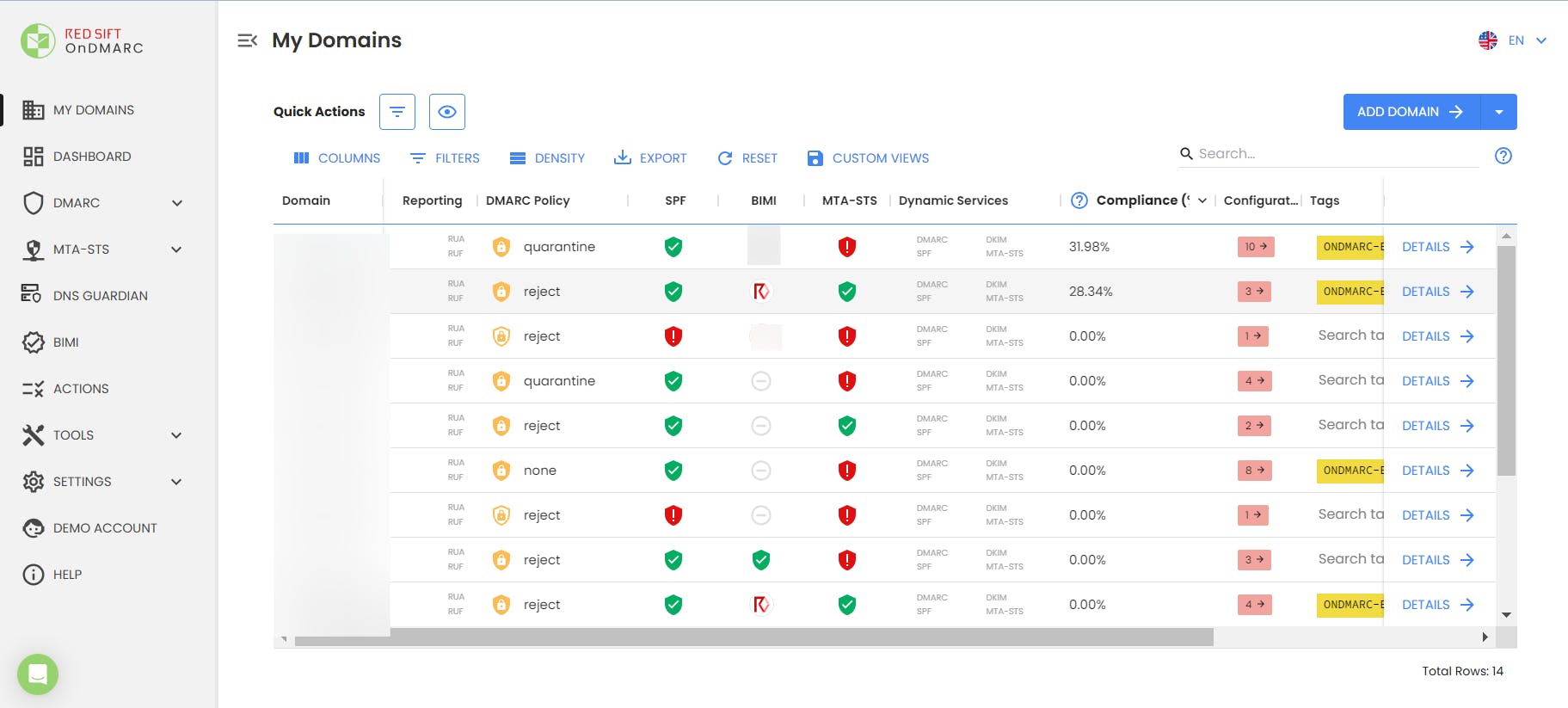

To get set up, you need to run through a short, three-step workflow to get the domains they want to protect into the application. The application will prompt you to select whether you’d like to set up Dynamic Services or opt to manually manage your DMARC. Dynamic Services allows for hosted management of all email records without the need to access the DNS, helping to avoid making manual configuration errors.
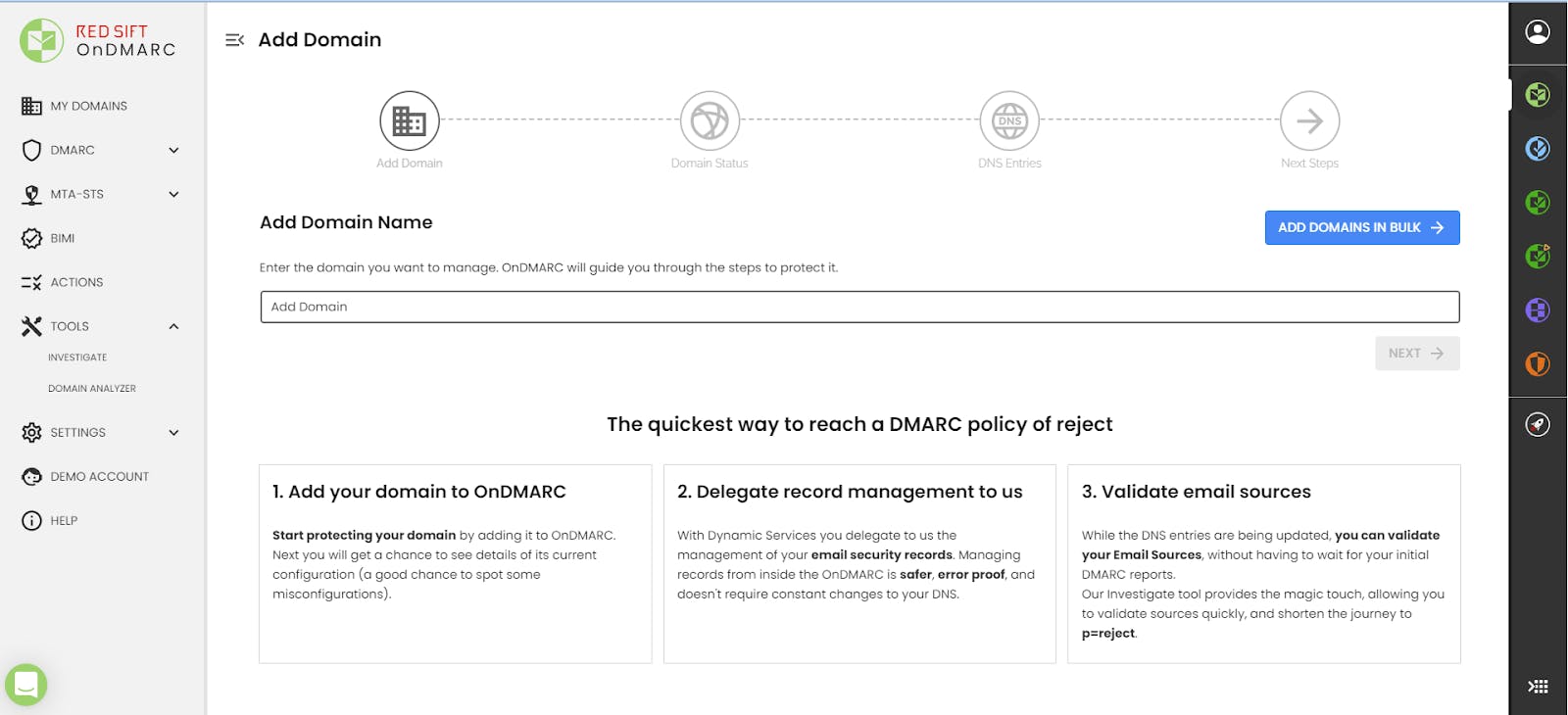

If you choose to use Dynamic Services, OnDMARC will provide the records you need to add to your DNS in order to start setting up Dynamic Services. If you opt for manual management, OnDMARC will provide the DMARC record for you to add to your DNS.
Once the necessary changes have been made to add the DMARC record to the user’s DNS, they must wait for DMARC reports to arrive from the mailbox providers who send them.
Configuration troubleshooting
DMARC reports can take up to 24 hours to arrive which is one of the reasons that DMARC projects can be time-consuming.
What makes Red Sift OnDMARC stand out from other DMARC solutions is its Investigate feature. This allows you to test configuration updates in real-time, avoiding the typical 24-hour wait for DMARC data. By enabling a fast feedback loop of configure > send test > view results > reconfigure, it drastically reduces the time needed for a DMARC project and accelerates the path to full protection.
It also ties in with your Email Sources asset list so you can see which app is using which SPF mechanism and DKIM selector, and if they’re properly authenticated.


Investigate extends beyond standard DMARC, SPF, and DKIM checks to deliver an enriched, comprehensive analysis of your FCrDNS, TLS, BIMI, MTA-STS, and IP reputation. It also identifies potential exposure to SubdoMailing attacks, assesses your compliance with Microsoft, Google and Yahoo bulk sender requirements, and more—consolidating these critical insights into a single view.
In addition to Investigate’s troubleshooting capabilities for DMARC implementations, it also features a number of Compliance Profiles that you can check your sending services against to make sure they’re compliant with the UK Minimum Cyber Security Standard, US Binding Operational Directive 18-01, or Microsoft, Google and Yahoo’s Bulk Sending requirements.
Inventory of email assets
Red Sift OnDMARC’s Email Sources view provides a comprehensive inventory of assets per domain. It enables you to categorize email-sending sources as assets or threats, store SPF components and DKIM selectors for each source, and document key details during DNS configuration.
This feature not only ensures you maintain an always up-to-date inventory, but also allows you to leave notes on internal ownership of each service. By keeping this information within the product, teams are equipped with continuity - ensuring that if team members leave, join, or take over the DMARC project, critical information remains easily accessible.


EasyDMARC
Getting started
EasyDMARC provides a straightforward 3-step onboarding process. After entering the domains you want to manage, you can choose to manage your email records directly through EasyDMARC or manually via your DNS host. If you opt for hosted management with EasyDMARC, you won’t need to access your DNS settings, which can help you avoid manual configuration errors.
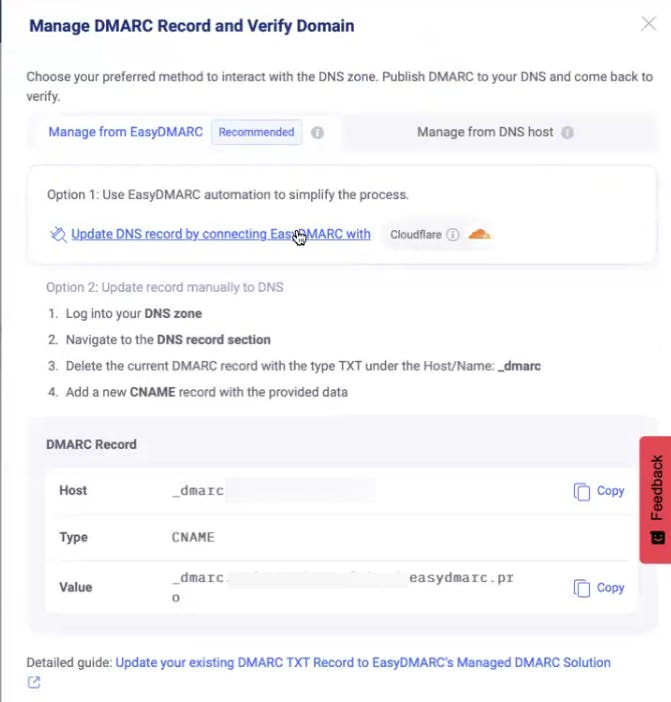

The flow recognizes your DNS host provider and provides a link to the Entri connector. The Entri connector automates DNS record updates via API, saving time and reducing the risk of manual errors. This tends to be a popular choice for small businesses and MSPs.
Once the set up is complete, you can see your added domains in the All Domains view. Unlike the Red Sift OnDMARC dashboard view, EasyDMARC’s My Domains view is more limited in what it displays, focusing on the DMARC policy, volume, SPF & DKIM pass rates, DMARC and SPF.


Configuration troubleshooting
EasyDMARC’s Email Investigation tool, like Red Sift OnDMARC’s, helps you bypass the usual 24-hour wait for DMARC reports by allowing you to check the configuration of your email records in real time.
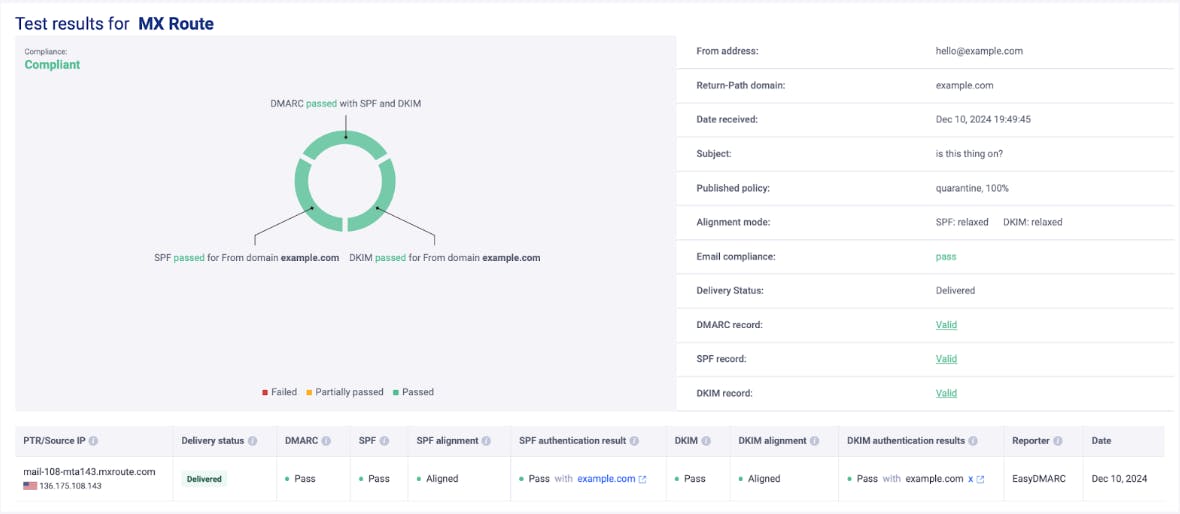

While EasyDMARC’s tool focuses on the three core email authentication protocols—DMARC, SPF, and DKIM—Red Sift OnDMARC’s Investigate tool provides a broader analysis by also including checks for FCrDNS, TLS, BIMI, and MTA-STS.
Inventory of email assets
EasyDMARC does not provide an Email Sources view similar to that of Red Sift OnDMARC where you can see both SPF parts and DKIM selectors. EasyDMARC only lets you see your sources for your SPF records.
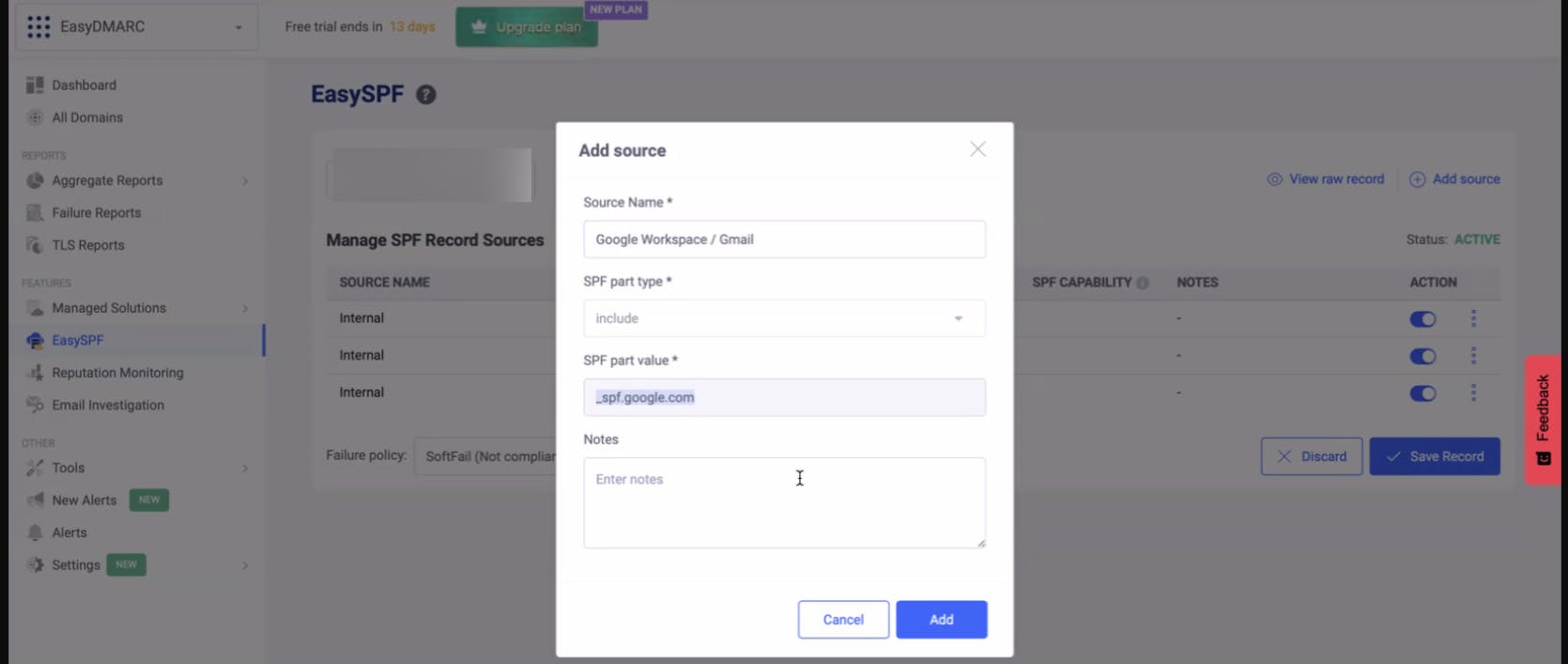

Hosted email records
Standard DNS implementations of SPF, DKIM, DMARC, and MTA-STS all suffer from the same problems - they are difficult to edit and error-prone, especially if you control multiple domains across multiple registrars.
Red Sift OnDMARC
Red Sift OnDMARC’s Dynamic Services solves this problem by allowing its users to control all of their records from within the OnDMARC app, avoiding the need to go into the DNS whenever updates need to be made to records. This is done by replacing the static DNS records with OnDMARC's smart records, either via NS delegation for DKIM and DMARC or a new smart TXT record for SPF.
Dynamic Services allows users to add additional SPF mechanisms, change their DMARC policy, or host 2048-bit DKIM keys that some DNS hosts do not support.
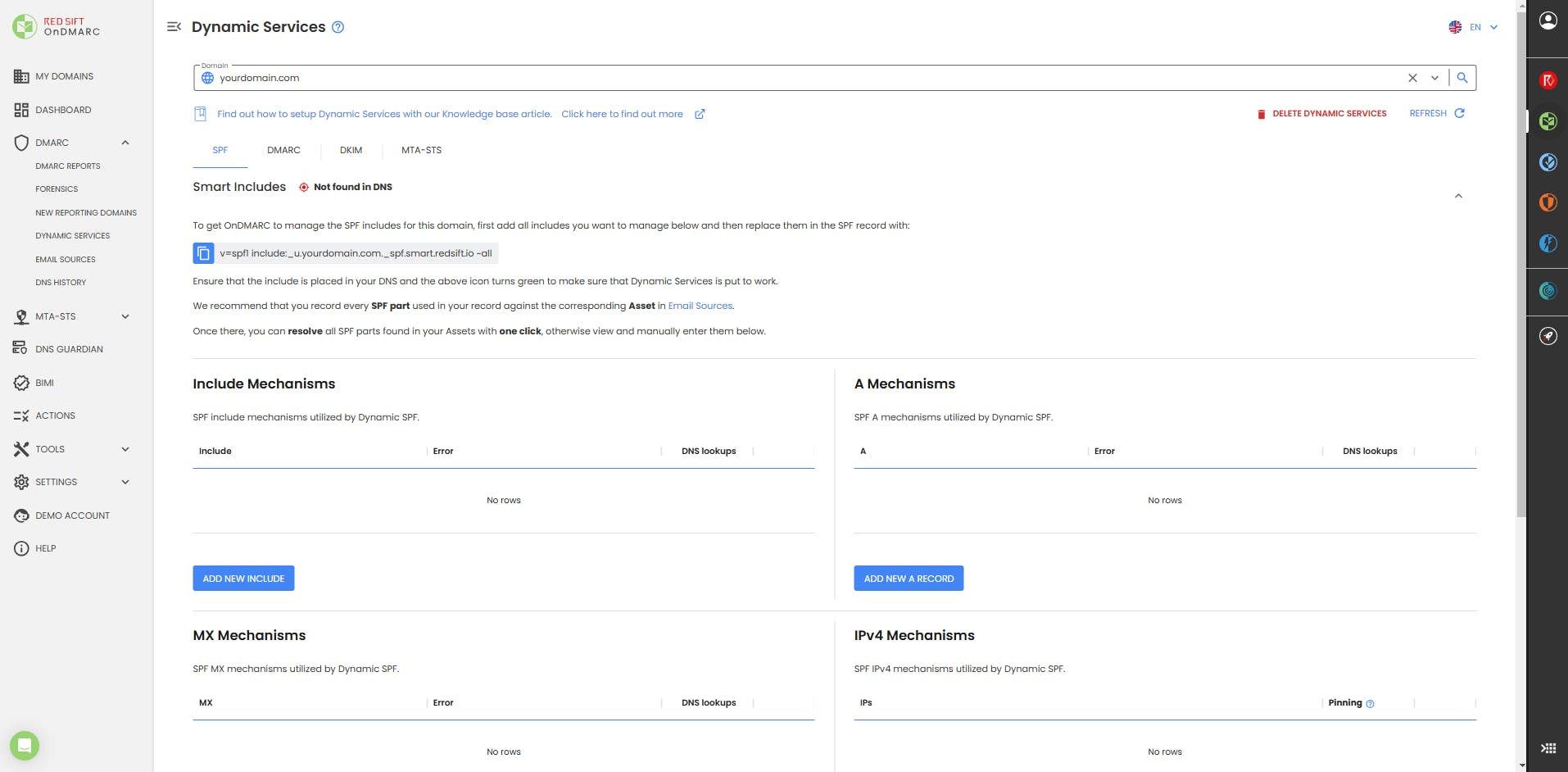

EasyDMARC
EasyDMARC offers hosted DMARC, SPF, DKIM, MTA-STS and BIMI.
Hosted SPF
Sender Policy Framework (SPF) is a mechanism that allows email senders to specify which servers are authorized to send emails on their behalf. By checking the SPF record in DNS, receiving servers can verify whether the email originates from a legitimate source, helping to prevent spoofing and phishing attacks.
However, SPF has limitations, such as the 10-DNS-lookup limit, which can cause legitimate emails to fail SPF checks if too many services are included in the record. Proper SPF management is crucial to ensure reliable email delivery and maintain domain reputation.
Hosted SPF simplifies SPF management by enabling you to delegate SPF configuration with a single DNS update. Once set up, future changes—such as adding or removing authorized servers—can be made seamlessly without further DNS updates, ensuring a faster, safer, and more efficient process.
Red Sift OnDMARC
OnDMARC’s Dynamic SPF feature helps you overcome the 10 SPF lookup limit by combining all authorized services in a single dynamic include. This prevents any authorized traffic from failing SPF validation and ensures uninterrupted mail flow.
Red Sift OnDMARC allows you to add any include mechanism for any provider, meaning you’re not limited to preconfigured assets like you are with some other DMARC providers. When a new source needs SPF configuring, it can be managed with a single click.
Dynamic SPF is not a macro-based SPF solution. Instead, it dynamically flattens and compacts IP records. Though macros are widely used, they are not supported by some legacy email infrastructure which results in the entire SPF authentication failing and mail not being delivered. For this reason, Red Sift OnDMARC was built to support but not rely on those macros, thus ensuring 100% compatibility with all legacy email structures, gateways, and receivers meaning email deliverability is never impacted.
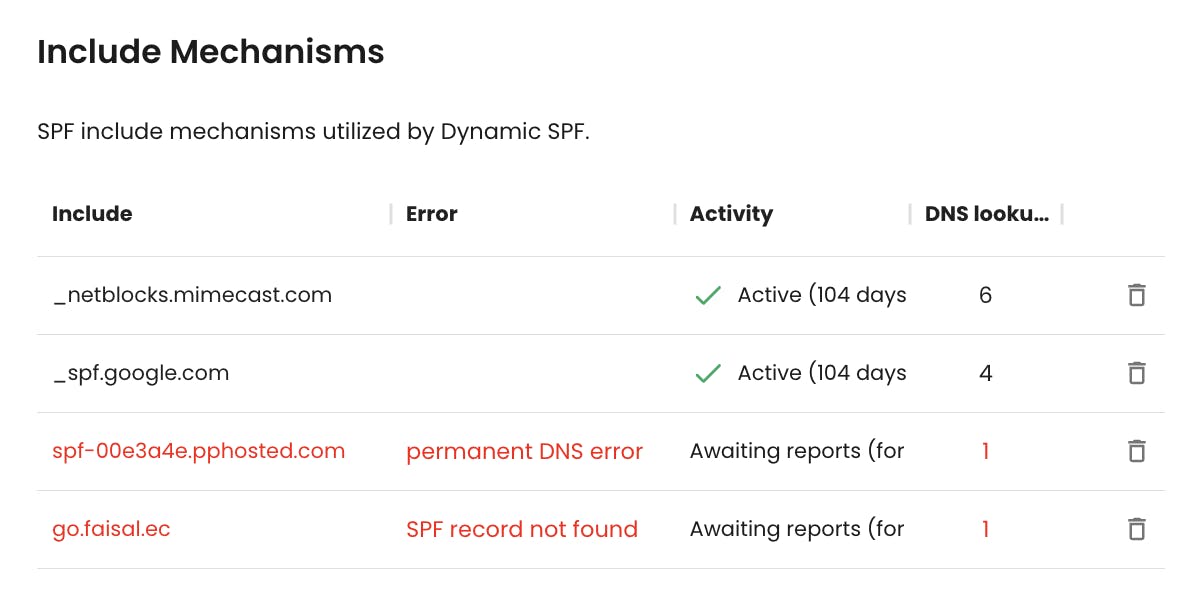

Dynamic SPF also makes it easy to clean up or remove unused or redundant mechanisms that are no longer necessary or needed. As shown in the Activity column above, OnDMARC tracks if a mechanism is active or not based on the info found in DMARC reports.
In addition, Dynamic SPF checks that the mechanisms inside an include are also valid. If it finds errors, it will flag them in the error column seen above.
EasyDMARC
SPF management
EasyDMARC’s hosted SPF feature is known as EasySPF.
EasySPF validates that ip4 mechanisms contain valid IPs and error-checks IPs within include mechanisms.
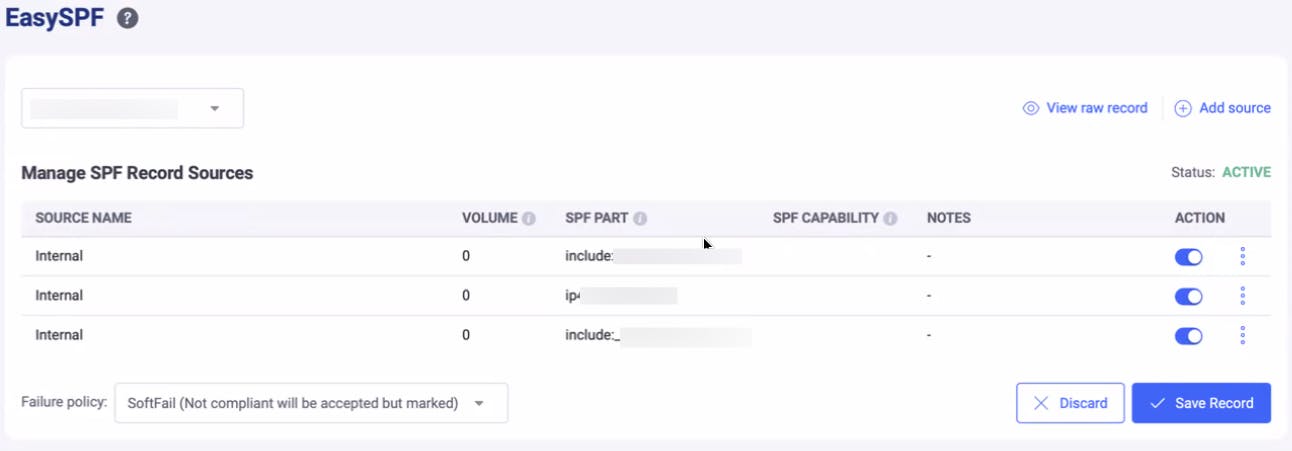

Hosted DKIM
DomainKeys Identified Mail (DKIM) is a mechanism that makes it possible to cryptographically verify the authenticity and integrity of email to ensure it has not been modified in transit. Unlike SPF, it makes it possible for emails to pass through multiple email systems, in particular forwarders, and still be verifiable and so pass DMARC. Ideally, all emails should use DKIM to ensure it has not been tampered with.
Some mailbox providers such as Google Gmail display a warning message for emails that have not been authenticated.
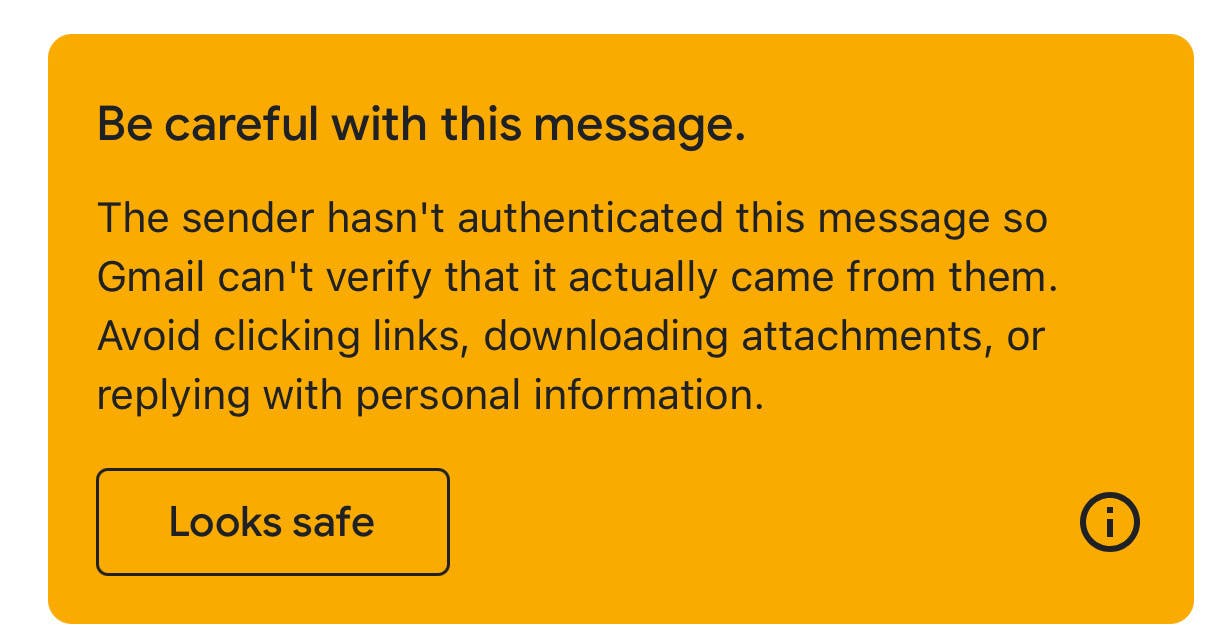

Hosted DKIM simplifies DKIM management by enabling you to delegate DKIM configuration with a single DNS update. Once set up, future configurations—such as adding, rotating or removing selectors—can be managed without further manual DNS changes, making the process faster, safer, and more efficient.
Red Sift OnDMARC
Red Sift OnDMARC offers Hosted DKIM through its Dynamic Services interface. This feature ensures DKIM DNS records are securely hosted, allowing you to configure DKIM for your sending services quickly and reliably. The platform also validates the DKIM keys you enter, eliminating common mistakes that could otherwise lead to undeliverable emails.
EasyDMARC
EasyDMARC provides a Hosted DKIM option.
Hosted MTA-STS
Mail Transfer Agent Strict Transport Security (MTA-STS) ensures the secure transmission of emails over an encrypted SMTP connection and stops man-in-the-middle (MITM) attacks.
Red Sift OnDMARC
Hosted MTA-STS is offered in OnDMARC’s Dynamic Services interface. OnDMARC will host the MTA-STS policy file, maintain the SSL certificate, and flag any policy violations through the TLS report.
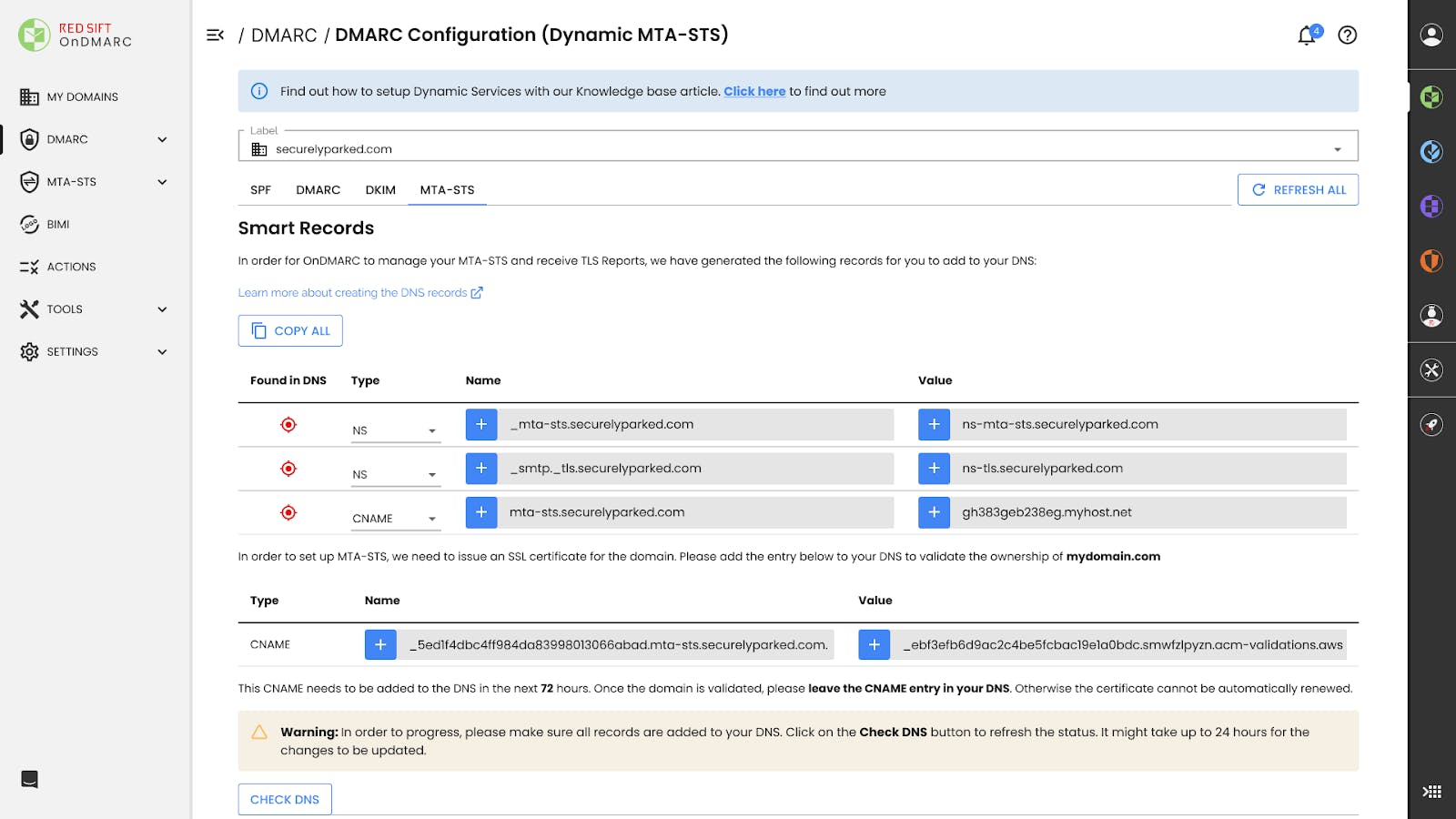

EasyDMARC
In addition to Red Sift OnDMARC, EasyDMARC is one of the few DMARC vendors that offers hosted MTA-STS and TLS-RPT. They host the MTA-STS file for you, guide you through making changes with your DNS provider, and generate human-readable TLS reports.
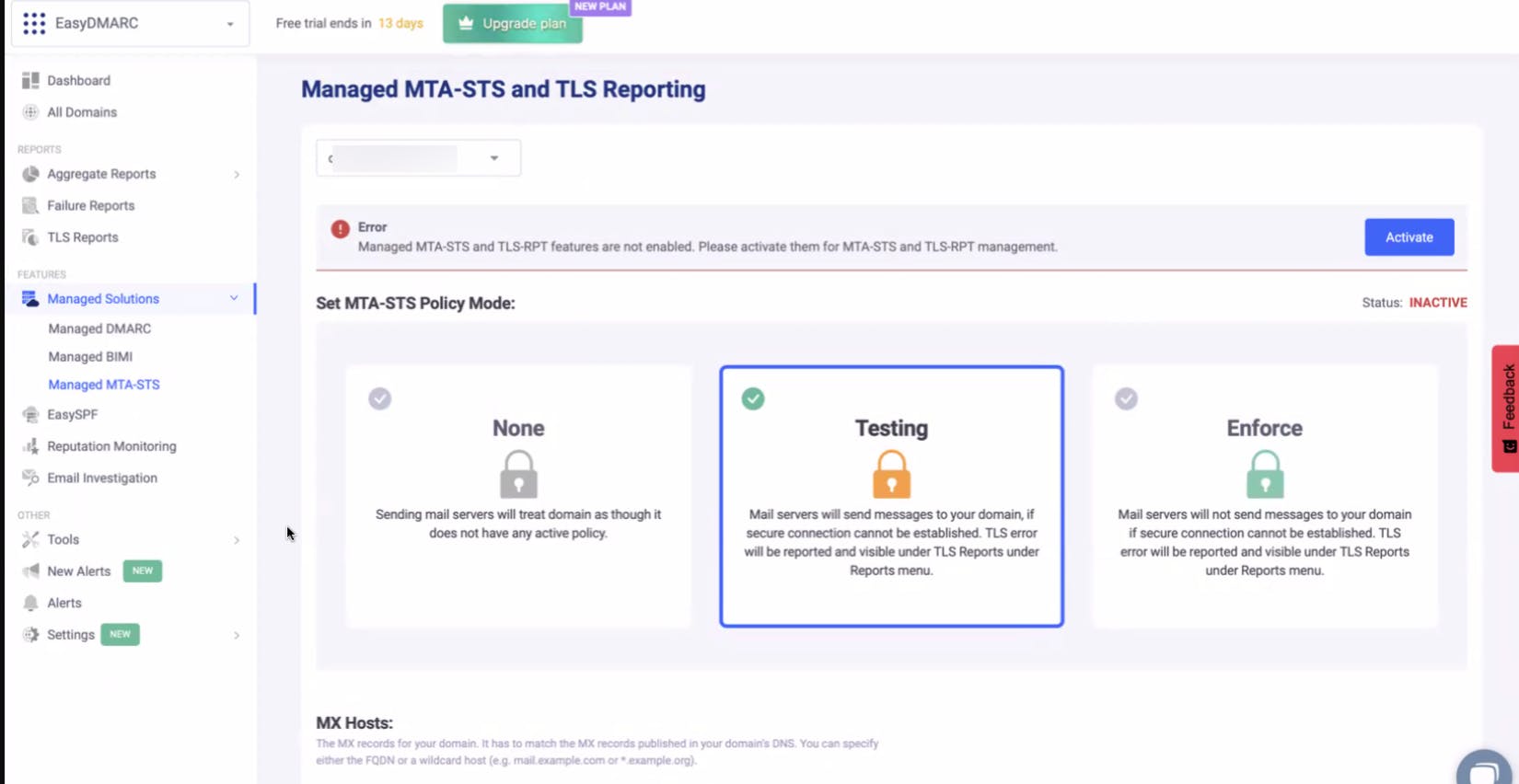

BIMI
Brand Indicators for Message Identification (BIMI) allows you to display your brand logo next to every DMARC-authenticated email you send. Studies suggest that BIMI can improve open rates by 39% and increase brand recall by 44%.
Red Sift OnDMARC
Red Sift OnDMARC offers the only integrated BIMI and Verified Mark Certificate (VMC) solution currently available. It helps you manage the entire BIMI application process, including obtaining a VMC—and soon, Common Mark Certificates (CMCs)—without needing to work directly with a Certificate Authority (CA).
Red Sift OnDMARC integrates directly with Entrust, the CA that issues VMCs. Application data is exchanged between Red Sift and Entrust via API. Once processed, Red Sift issues the VMC and ensures you are BIMI-ready.
Red Sift OnDMARC is Entrust’s preferred DMARC partner and the only DMARC solution using Entrust’s API. Additionally, its Enterprise tier includes a free VMC license, eliminating the need for additional budget for BIMI.
EasyDMARC
With EasyDMARC’s managed BIMI, you can host your logo and manage and monitor your BIMI record directly within the platform. However, EasyDMARC does not offer integrated VMC provisioning or partnerships with Certificate Authorities such as Entrust or Digicert.
DNS configuration monitoring
Threats are becoming increasingly sophisticated, with tactics like SubdoMailing enabling attackers to bypass DMARC and send fraudulent emails that appear legitimate. These attacks often target misconfigured or inactive DNS records and subdomains, underscoring the importance of maintaining strong DNS hygiene. Implementing DNS configuration monitoring provides an additional layer of security, helping organizations proactively identify and address vulnerabilities.
Red Sift OnDMARC
Red Sift OnDMARC includes DNS Guardian, a feature that enables you to quickly identify and resolve potential vulnerabilities within your DNS, such as those resulting from domain takeovers, SubdoMailing attacks, dangling DNS records and CNAME takeovers. It provides actionable guidance on how to resolve an issue when it has been detected and what exactly to look for in your DNS.
By combining advanced DNS knowledge with Red Sift ASM’s dynamic inventory of public-facing assets, Red Sift OnDMARC provides a unique level of visibility into your domain infrastructure. This capability helps proactively mitigate risks from attacks like SubdoMailing and ensures your domains remain secure.


EasyDMARC
EasyDMARC does not include DNS configuration monitoring as part of its feature set.
Embedded LLM assistant
Large Language Models (LLMs) and AI assistants like GPT-4 offer significant value by providing quick answers and troubleshooting support. However, for security teams, these tools often aren't integrated into existing workflows or customized with cybersecurity-specific intelligence, which can limit their effectiveness. When vendors embed this advanced technology into security processes, it adds substantial value by saving time and streamlining workflows.
Red Sift OnDMARC
Red Sift OnDMARC integrates with Red Sift Radar, making it the first DMARC application to include an embedded, specialized LLM. This feature helps you identify misconfigurations, syntax errors, and exposures in your email system that could compromise its integrity. If you're implementing DMARC, this integration can accelerate issue detection and support a quicker progression to DMARC enforcement (p=reject), ensuring that robust email security policies are effectively enforced.


EasyDMARC
At the time of publication, EasyDMARC does not offer an LLM or an AI assistant.
Alerting and notifications
Effective alerting capabilities enable you to respond swiftly to potential threats, minimizing the impact of phishing and other malicious activities.
Red Sift OnDMARC
OnDMARC’s Notifications feature allows you to set up daily or weekly compliance reports, action reminders, and configuration alerts, which can be delivered to your preferred email or Slack channel.
The reports and alerts include:
- DNS Alerts: Get notified of any changes to your DNS records for DMARC, SPF, and MX.
- Threshold Alerts: Set custom thresholds for SPF and/or DKIM failures, receiving alerts when these thresholds are exceeded. For example, "Alert me if more than 10% of emails fail SPF in the last week." Thresholds can be defined as a percentage or an absolute value.
- Compliance Reports: Receive summaries of email volumes categorized by pass, quarantine, and reject statuses for specified domains.
- Action Reminders: Stay on top of outstanding actions for your domains with tailored reminders.
EasyDMARC
EasyDMARC provides email alerts for the following:
- DNS Record Alerts: Users can set up alerts for specific DNS records such as DMARC, SPF, and DKIM across one or multiple domains. Notifications are sent if the records fail validation or undergo changes.
- Blacklist Monitoring Alerts: Domains can be monitored for blacklist status, with notifications triggered when a domain is added to or removed from a blacklist.
Tools
Effective DMARC management requires a robust set of tools to ensure the correct configuration of your DMARC, SPF, DKIM, BIMI, and other email authentication protocols. These tools play a critical role in identifying misconfigurations and maintaining the integrity of your email-sending domains.
Red Sift OnDMARC
Red Sift Investigate is useful if you want to ensure your mail flow’s configuration is correct. The tool provides an easy-to-digest overview of your evolving setup in an instant.
If you are working on an active DMARC implementation, the instant visibility Investigate provides drastically reduces the time needed to check up on your evolving setup and speeds up the time needed until full protection is reached. Without a tool like Investigate, you would have to wait up to 24 hours for a DMARC report to arrive that would show you if the changes you made had the desired outcome.
Red Sift also provides a web version of Investigate for non-OnDMARC customers so anyone, whether they are a Red Sift customer or not, can quickly check their email configuration.
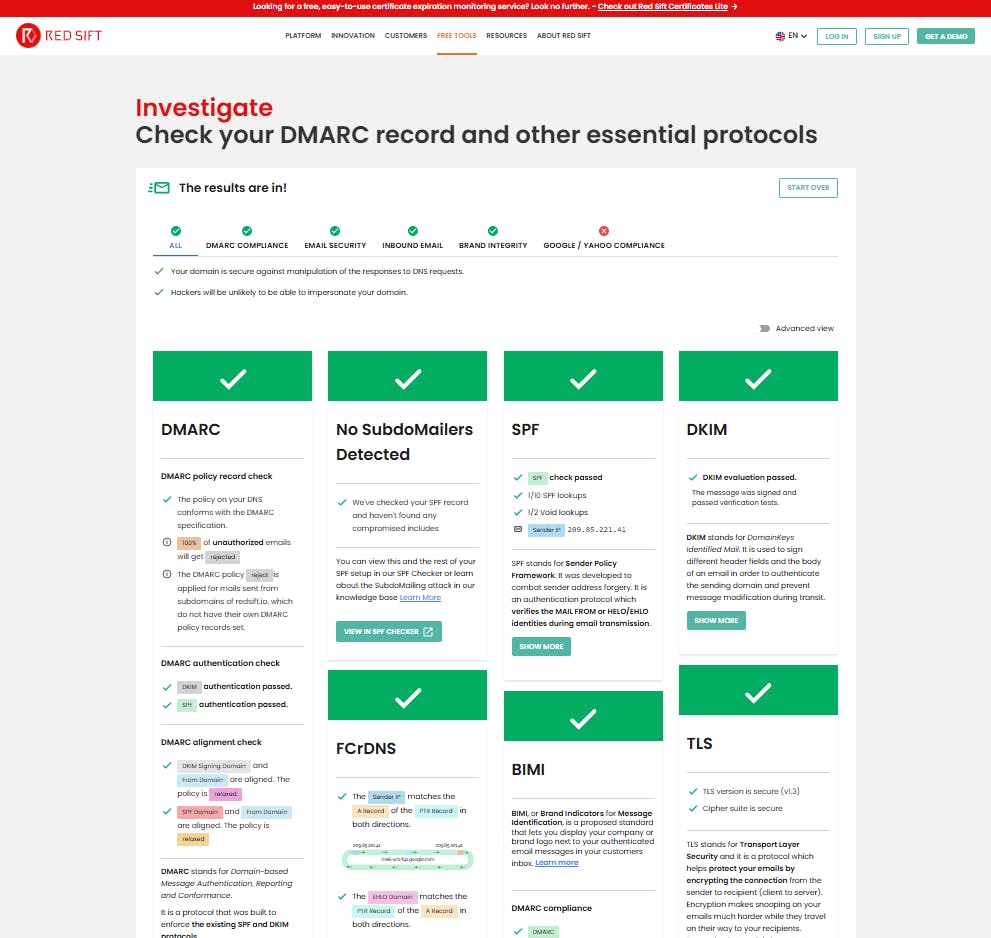

In addition to Investigate, Red Sift OnDMARC includes the following in its portfolio of tools:
- Domain Analyzer: Investigate the health of any domain.
- IP Lookup: Retrieve detailed insight about any IPv4 or IPv6 address, such as it’s owner, DMARC, SPF and DKIM compliance rates, sending volumes and how many domains that report into OnDMARC use the IP address to send email.
- SPF Checker: A web-based tool that examines and validates a domain's SPF configuration by checking for an SPF record in the domain's DNS, evaluating the number of lookups, detecting syntax errors or common issues such as void lookups or incorrect mechanisms. It offers a dynamic visualization of the "SPF tree," illustrating each resolution of the SPF record to provide in-depth inspection of the configuration.
EasyDMARC
EasyDMARC has a range of tools available across its website and included in its product, including its Email Investigation tool that looks up DMARC, SPF and DKIM records, record checkers for DMARC, SPF, DKIM, BIMI and MTA-STS, and more, including:
- Domain Scanner: Analyzes the risk signals for DMARC, SPF, and DKIM. While the domain tested in the screenshot is fully protected and set to reject, EasyDMARC’s scoring system may penalize your score if reporting is not directed to their platform—an approach that may not align with best practices for unbiased assessment.
- Reputation Check: EasyDMARC’s IP reputation checker includes certain blacklist checks, such as SpamCop (a notable third-party provider), but overlooks key industry leaders like Spamhaus, Abusix, and SURBL—recognized for their robust domain and IP blacklist monitoring. Instead, it focuses on smaller or outdated lists, some of which are no longer active (e.g., Pan-Am, No-More-Funn, and CNCZ).
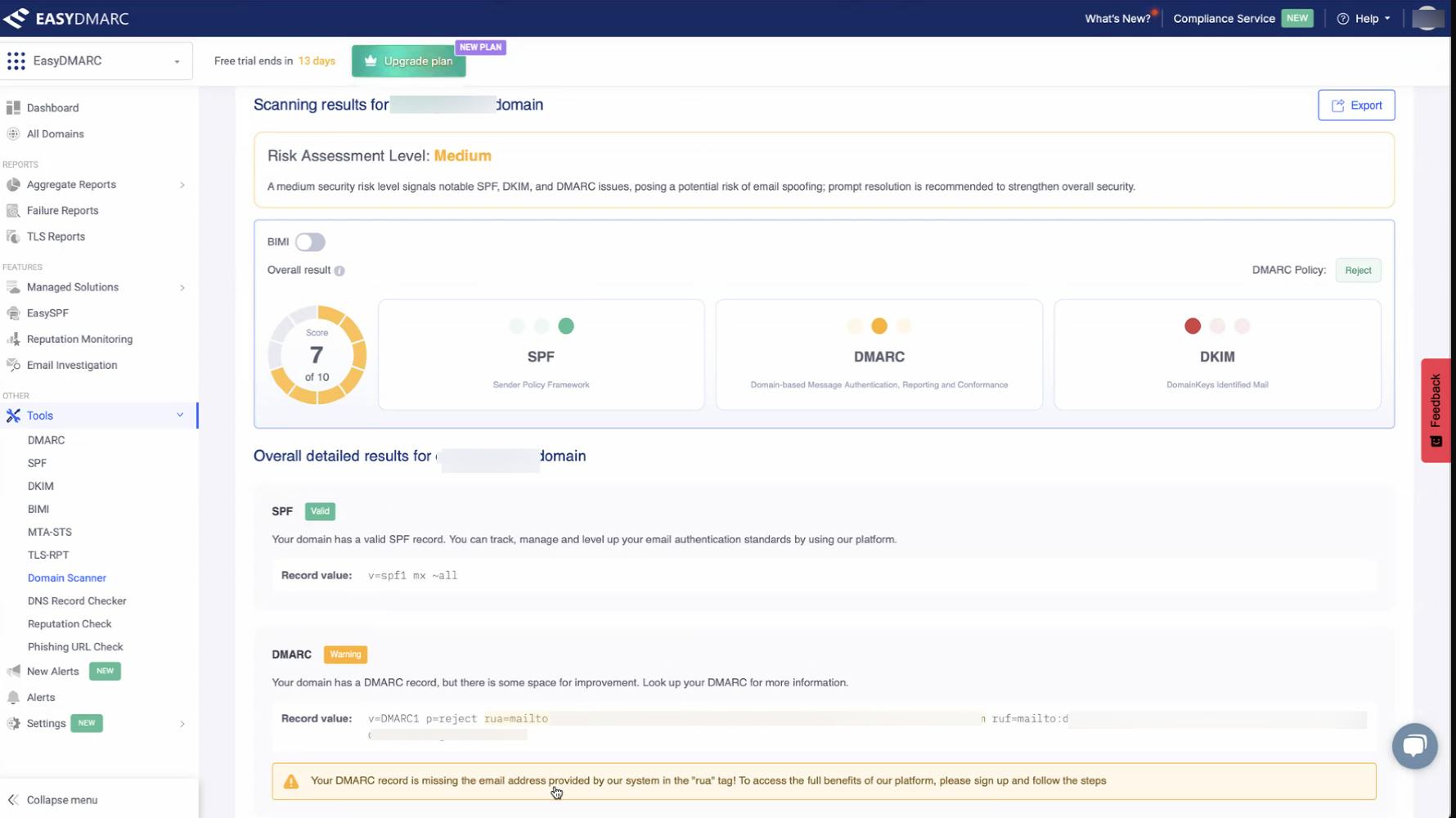

Customer Success
Successfully implementing DMARC and achieving enforcement requires careful planning and support. A vendor’s Customer Success team can play a crucial role in guiding you through the process, helping you progress efficiently and securely.
Red Sift OnDMARC
With Red Sift OnDMARC, you gain access to the Customer Success Engineering (CSE) team at the Enterprise level. This global team provides deep technical expertise across all email authentication standards, helping you tackle even the most complex DMARC implementations.
Red Sift’s CSEs have extensive experience working with organizations such as Capgemini, Biogen, ZoomInfo, and TUI. Enterprise customers like Holland & Barrett, ZoomInfo, and TalkTalk have praised the quality of Red Sift’s Customer Success team.
Red Sift OnDMARC has consecutively been recognized as a G2 leader in the DMARC category for a number of years. In Spring 2025, Red Sift OnDMARC was awarded #1 in EMEA and #1 in Europe in the DMARC category, reflecting not just how many customers trust the product and the support, but how strongly they feel about the experience, from product value to support and ease of use.
The strength of Red Sift’s Customer Success is reflected in its high satisfaction metrics, with an NPS of 62 and a CSAT of 88. These results are a key reason why Cisco selected Red Sift OnDMARC as its chosen DMARC partner.
EasyDMARC
EasyDMARC’s Premium and Enterprise packages include a dedicated DMARC engineer and a Customer Success Manager. eIf you are on a lower-tier plan, EasyDMARC offers tailored support options to fit your subscription level, ensuring you have access to the assistance you need.
EasyDMARC’s customer support frequently earns positive feedback on review platforms like G2, reflecting its commitment to helping users implement and manage their DMARC projects effectively.
APIs and integrations
Red Sift OnDMARC
OnDMARC has a REST API that can be used to integrate with custom dashboards and other internal systems. All endpoints are documented here with working examples. Capabilities include managing Dynamic Services, creating customer charts from reporting data, adding and removing domains, configuring alerts, or analyzing any domain programmatically.
EasyDMARC
EasyDMARC also has an API.
Sharing intelligence with other tools
Red Sift OnDMARC
Red Sift OnDMARC has access to a Spamhaus data feed that flags bad actors as well as legitimate sources that may be getting flagged and causing deliverability issues. It also has an integration with Validity whose data feeds enhance Red Sift’s ability to monitor brand spoofing and phishing for customer domains as they relate to DMARC. In addition,Red Sift is one of only two DMARC vendors with access to the Yahoo forensics feed that enhances forensic reporting.
Red Sift OnDMARC is one of four interoperable products on the Red Sift Pulse Platform. OnDMARC and Brand Trust, Red Sift’s impersonation discovery application, sync to automatically add your domain assets into Brand Trust and then start looking for similar domains that may be impersonating your brand.
EasyDMARC
EasyDMARC is a standalone DMARC product. It has integrations with Acronis and ConnectWise.
Which one to choose?
When it comes to securing your email-sending domains, both Red Sift OnDMARC and EasyDMARC provide valuable solutions. However, Red Sift OnDMARC stands out with its advanced capabilities, including Dynamic SPF, integrated BIMI and VMC provisioning, DNS configuration monitoring, and an embedded LLM assistant. These features not only streamline DMARC implementation but also ensure robust, future-proof protection for your organization.
For businesses of all sizes—from SMBs to enterprises—Red Sift OnDMARC delivers unmatched value with faster time to enforcement, enriched forensic insights, and tools that simplify even the most complex setups. Whether you're looking to protect your brand, improve email deliverability, or prevent domain impersonation, Red Sift OnDMARC offers the most comprehensive solution on the market.
Ready to take control of your email security? Start your 14-day free trial of Red Sift OnDMARC today and experience the difference for yourself.







